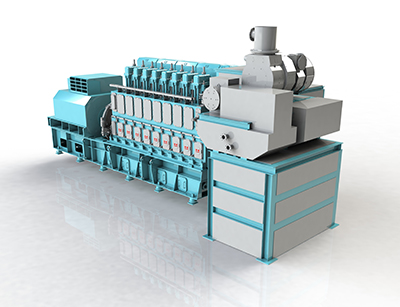World’s First AiP Granted to Kawasaki’s 2.4 MW Class Dual Fuel Generator Engine Using Hydrogen Gas as Fuel
Nov. 30, 2022

Tokyo, November 30, 2022 — Kawasaki Heavy Industries, Ltd. announced today that an Approval in Principle (AiP)*1 was granted by Nippon Kaiji Kyokai (ClassNK) for Kawasaki’s dual fuel (DF) generator engine using hydrogen gas as fuel, which will be installed on a 160,000 m3 liquefied hydrogen carrier developed by Kawasaki.
This DF engine allows operators to flexibly alternate between the use of hydrogen fuel and conventional low-sulfur fuel oil. When hydrogen fuel is selected, the boil-off gas that evaporates naturally from the vessel’s liquefied hydrogen cargo tanks is used as the main fuel at a calorie-based ratio of 95% or higher*2 to generate electric power for the vessel, which results in a significant reduction of greenhouse gas emissions.
Kawasaki has a track record of selling more than 200 units of engines fueled solely by natural gas. To expand its product portfolio, Kawasaki developed combustion technologies tailored to hydrogen’s properties - a fast combustion speed, which often results in backfire, and a high combustion temperature - and in a demonstration test using a single-cylinder test engine, the company achieved stable combustion of hydrogen without causing abnormal combustion or the overheating of parts in the combustion chamber. Development of this engine was the result of its being selected as a Green Innovation Fund Project of the New Energy and Industrial Technology Development Organization (NEDO). Kawasaki intends to conduct a demonstration test of this engine after installing it on a large-scale liquefied hydrogen carrier which is planned to be commercialized in the mid-2020s.
As Kawasaki foresees a significant increase in the use of hydrogen energy in the future, which will play a vital role in achieving a decarbonized society, the company is developing a range of technologies for a hydrogen supply chain (production, transportation, storage, and utilization). The technology used for this engine serves the “transportation” and “utilization” stages, covering both the demand and supply aspects of the supply chain. Moving forward, Kawasaki will continue to develop more products that capitalize on hydrogen energy, contributing to the realization of carbon neutrality.

| Specifications of DF generator engine using hydrogen gas as fuel | |
|---|---|
| Rated output | 2,400 kWe (when hydrogen fuel is used) |
| Cylinder diameter | 300 mm |
| *1 | At the initial stage of designing or before a decision is made regarding which ship on which the product will be used, the product’s design is examined based on existing regulations, such as international treaties and ship classification rules, and an Approval in Principle (AiP) is issued as proof of conformity with such requirements. This time, an AiP was granted by ClassNK based on the result of a risk assessment using the International Code for the Construction and Equipment of Ships Carrying Liquefied Gases in Bulk (the IGC Code, to which all liquefied gas carriers built during and after 1986 must conform, and which is included in ClassNK’s rules for steel ships) and the Hazard Identification Study (HAZID, a method of assessing risks which are determined by experts based on the frequency with which potential hazards in a system arise, and aimed at identifying ways to minimize that frequency). |
| *2 | A calorie-based ratio of hydrogen boil-off gas to low-sulfur fuel oil. |
Contact
If you need more information about our business,
please feel free to contact us.





